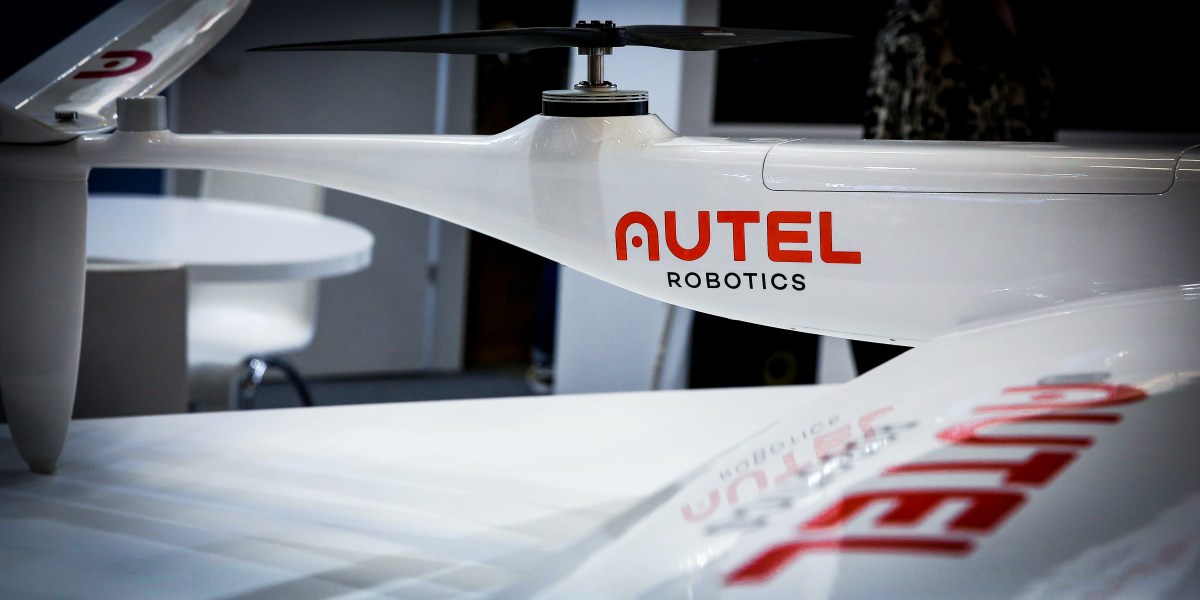Chinese-made Autel drones, which have been widely used in Ukraine, are shown for sale carrying what appear to be explosive shells.
A forthcoming drone made by Autel, a Chinese electronics manufacturer and drone-maker, is being marketed using images of the unmanned aerial vehicle carrying a payload of what appears to be explosive shells. The images were discovered just two months after the company condemned the military use of its flying robots.
Two separate online retail preorder listings for the $52,000 Autel Titan drone, with a cargo capacity of 22 pounds and an hour of flight time, advertised a surprising feature: the ability to carry (and presumably fire) weapons.
In response to concerns from China-hawk lawmakers in the U.S.Opens in a new tab over Autel’s alleged connections to the Chinese government and its “potentially supporting Russia’s ongoing invasion of Ukraine,” according to a congressional inquiry into the firm, Autel issuedOpens in a new tab a public statement disowning battlefield use of its drones: “Autel Robotics strongly opposes the use of drone products for military purposes or any other activities that infringe upon human rights.” A month later, it issued a second, similarly worded denialOpens in a new tab: “Autel Robotics is solely dedicated to the development and production of civilian drones. Our products are explicitly designed for civilian use and are not intended for military purposes.”
It was surprising, then, when Spanish engineer and drone enthusiast Konrad Iturbe discoveredOpens in a new tab a listing for the Titan drone armed to the teeth on OBDPRICE.com, an authorized reseller of Autel products. While most of the product images are anodyne promotional photos showing the drone from various angles, including carrying a generic cargo container, three show a very different payload: what appears to be a cluster of four explosive shells tucked underneath, a configuration similar to those seen in bomb-dropping drones deployed in Ukraine and elsewhere. Samuel Bendett, an analyst with the Center for Naval Analyses, told The Intercept that the shells resembled mortar rounds. Arms analyst Patrick Senft said the ordnance shown might actually be toy replicas, as they “don’t resemble any munitions I’ve seen deployed by UAV.”
Contacted by email, an OBDPRICE representative who identified themselves only as “Alex” told The Intercept: “The drone products we sell cannot be used for military purposes.” When asked why the site was then depicting the drone product in question carrying camouflage-patterned explosive shells, they wrote: “You may have misunderstood, those are some lighting devices that help our users illuminate themselves at night.” The site has not responded to further queries, but shortly after being contacted by The Intercept, the mortar-carrying images were deleted.
Iturbe also identified a separate listing from an Autel storefront on eBayOpens in a new tab using the very same three images of an armed Titan drone. When asked about the images and whether the drone is compatible with other weapons systems, the account replied via eBay message: “The bombs shown in the listing for this drone is just for display. Pls note that Titan comes with a standard load of 4 kilograms and a maximum load up to 10 kilograms.”
The images bear a striking resemblance to ordnance-carrying drones that have been widely used during the Russian invasion of Ukraine, where their low cost and sophisticated cameras make them ideal for both reconnaissance and improvised bombing runs. Autel’s drones in particular have proven popularOpens in a new tab on bothOpens in a new tab sidesOpens in a new tab of the conflict: A March 2023 New York Times reportOpens in a new tab found that “nearly 70 Chinese exporters sold 26 distinct brands of Chinese drones to Russia since the invasion. The second-largest brand sold was Autel, a Chinese drone maker with subsidiaries in the United States, Germany and Italy.” A December 2022 report from the Washington Post, meanwhile, citedOpens in a new tab Autel’s EVO II model drone as particularly popular among volunteer efforts to source drones for the Ukrainian war effort.
Last summer, researchersOpens in a new tab who’ve closely followed the use of drones in the Russia–Ukraine war documentedOpens in a new tab an effort by two Russian nationals, self-chronicled via Telegram, to obtain Chinese drones for the country’s ongoing war in Ukraine. Their visit to Shenzhen resulted in a meeting at an Autel facility and the procurementOpens in a new tab, the individuals claimed, of military-purpose drones.
Autel’s New York-based American subsidiary did not respond to a request for comment.
read more: https://theintercept.com/2024/01/06/autel-chinese-drones-bombs-weapons/
No no no, those are just lighting devices.
Very brief but very bright lighting devices.
Those aren’t bombs, they are for dropping candy on birthday parties.
“Yeah it’s true, we’re not going to use them in war, we’re just going to drop them on civilians”
This is the best summary I could come up with:
A forthcoming drone made by Autel, a Chinese electronics manufacturer and drone-maker, is being marketed using images of the unmanned aerial vehicle carrying a payload of what appears to be explosive shells.
Two separate online retail preorder listings for the $52,000 Autel Titan drone, with a cargo capacity of 22 pounds and an hour of flight time, advertised a surprising feature: the ability to carry (and presumably fire) weapons.
Samuel Bendett, an analyst with the Center for Naval Analyses, told The Intercept that the shells resembled mortar rounds.
Arms analyst Patrick Senft said the ordnance shown might actually be toy replicas, as they “don’t resemble any munitions I’ve seen deployed by UAV.”
Contacted by email, an OBDPRICE representative who identified themselves only as “Alex” told The Intercept: “The drone products we sell cannot be used for military purposes.” When asked why the site was then depicting the drone product in question carrying camouflage-patterned explosive shells, they wrote: “You may have misunderstood, those are some lighting devices that help our users illuminate themselves at night.” The site has not responded to further queries, but shortly after being contacted by The Intercept, the mortar-carrying images were deleted.
The images bear a striking resemblance to ordnance-carrying drones that have been widely used during the Russian invasion of Ukraine, where their low cost and sophisticated cameras make them ideal for both reconnaissance and improvised bombing runs.
The original article contains 672 words, the summary contains 232 words. Saved 65%. I’m a bot and I’m open source!
Removed by mod




